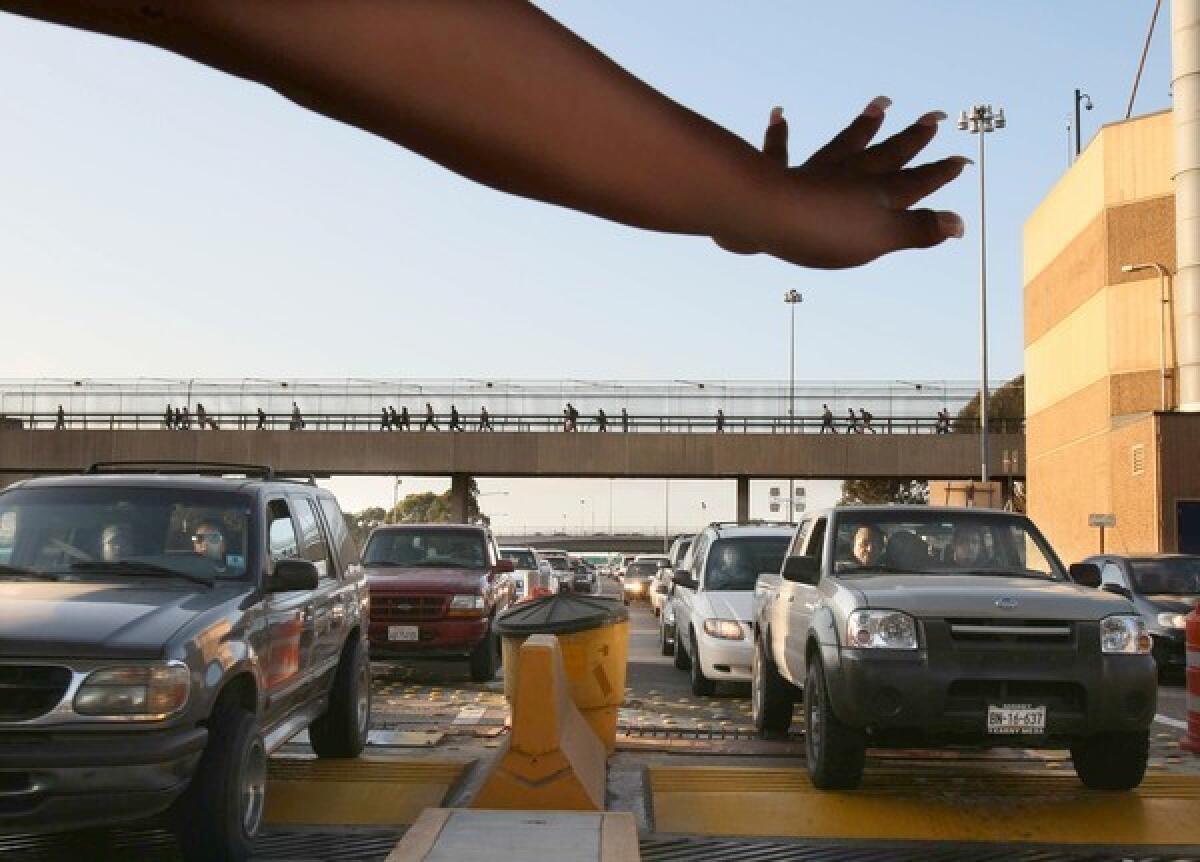Mexico tightens security at U.S. border crossings

- Share via
Reporting from Tijuana — Driving into Mexico has been a largely hassle-free experience for decades: There were few customs inspectors, even fewer gates, and for most border crossers, no questions asked.
That’s about to change.
The Mexican government is modernizing its ports of entry along the border, including its biggest crossing in Tijuana. The new infrastructure -- which includes gates, cameras and vehicle scales -- is meant to help curtail the flow of drug money and weapons to Mexican organized crime groups.
But bolstered security means more border-crossing logjams, and business and trade groups fear that the new measures will deal another blow to a fragile regional economy.
The System of Supervision and Vehicular Control is still in the testing phase ahead of its scheduled January rollout, but traffic jams already occur regularly at peak crossing times in late afternoon. Cross-border trips from San Diego that once took five minutes can take an hour or more.
Baja California Gov. Jose Guadalupe Osuna Millan, fearing more damage to the collapsing tourism industry if increased wait times discourage Southern Californians from venturing south, has lobbied federal authorities to scale back the inspection process.
But President Felipe Calderon, under pressure to show progress in his nearly three-year offensive against drug cartels, declined, saying the measures are a necessary sacrifice. Since 2008, more than 1,000 people have been slainin Tijuana, many of them with guns believed to have been obtained in the U.S.
“We want security,” Calderon said on a recent trip to Tijuana. “This requires sacrifice and measures that permit us to stop the trafficking of weapons, drugs, drug money and criminals across this border.”
Intercepting the flow of contraband has always caused a headache for northbound travelers. Motorists in Tijuana sit in a sea of traffic waiting to be inspected by U.S. agents who run through a battery of checks, including license, passport and, in some cases, criminal background reviews.
Tijuana customs inspectors in the past conducted random checks and focused on people trying to avoid paying duties on shipments of secondhand clothing, or traffickers bringing hard-to-find drugs, such as Ecstasy, into Mexico. They also found the occasional rooster being smuggled onto the Tijuana cockfighting circuit.
Mexico’s new process doesn’t approach the sophistication and strictness of U.S. inspections levels, but still represents a dramatic change.
Instead of motorists driving directly onto Tijuana streets, a gate will block the way. License-plate photographs will be run against a criminal database in Mexico City; a scale and vehicle-scanning system will determine if the car may be overloaded with contraband; and canine units will roam the area.
Suspicious vehicles will be directed to a secondary inspection area staffed by inspectors and Mexican marines.
The process, Mexican officials say, should take about eight seconds per car, but business leaders have their doubts. And even an eight-second wait translates into traffic snarls at peak crossing times.
“It adds another brake to the cross-border economic engine. People are already not sure of passport requirements and worried about cartel violence across the border,” said Kenn Morris, president of the Crossborder Group Inc., a San Diego-based market research firm. “And as word spreads that southbound border waits can take 30-40-60 minutes out of your life. . . . It’s going to really highlight the lack of infrastructure and progress in creating efficient border crossings in our region.”
On a recent late afternoon, the long wait times were on full display. Claudia Serrano, a San Diego resident, said she waited about 20 minutes, much longer than the five minutes it used to take her to cross into Tijuana. She was taking her children to a relative’s birthday party, but had been ordered into the secondary inspection area, a rare occurrence in the past.
Serrano, an import-export broker who crosses twice daily, can’t avoid the waits. But she said many of her Mexican friends don’t cross anymore. “They hate waiting so long.”
Some Americans didn’t seem bothered by the slow crossing, including those heading south last weekend for the Baja 1000 off-road race. Traveling in convoys of trucks pulling expensive dune buggies and motorcycles, many said they appreciated the extra security. “It’s a sign of the times,” said Jim Blackmore, a member for the Riviera Racing Team.
Some experts question whether the new measures will affect southbound flows of contraband, pointing out that U.S. inspectors intercept a fraction of the drugs entering the U.S., despite having even more sophisticated detection methods. Mexican authorities say they’re confident that the inspections will enhance their ability to spot traffickers.
“There’s a lot of information we can exploit here,” said Cesar Montoya, the port director.
The people most affected will be daily cross-border commuters like Richard Corona, 32, whose waits total more than one hour on some days. Corona, a construction worker, moved his family from the San Diego area to lower-cost Tijuana last year due to the slowdown in the construction industry.
“I’m thinking of going back,” said Corona, waiting about 20 minutes for Mexican officials to inspect his Ford Escape. “This is not even worth it.”
More to Read
Sign up for Essential California
The most important California stories and recommendations in your inbox every morning.
You may occasionally receive promotional content from the Los Angeles Times.











